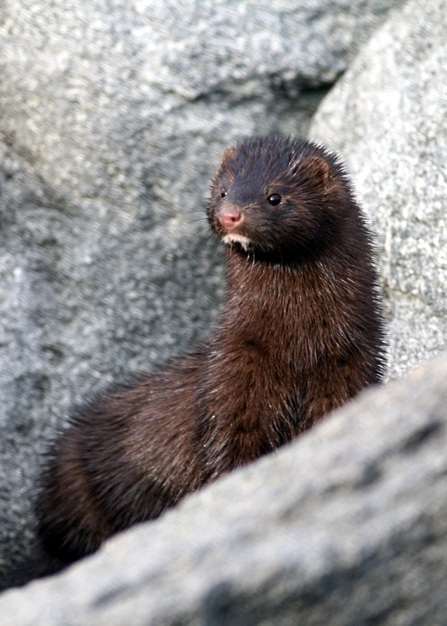American mink are an invasive non-native species which can decimate local water vole populations as well as being a problem for other animals like fish and ground nesting birds. They are skilled predators who, by virtue of their small size and semi aquatic lifestyle, fill a niche in our food chain that none of our native species have evolved alongside. In particular, our native water voles unfortunately are completely defenceless against them.
Watch out… there’s mink about!
With autumn just around the corner, we are now entering the American mink dispersal season.

Late Summer/early Autumn is ‘dispersal season’ for young mink, meaning that the young born this year are leaving their mothers and exploring out to find their own territory. We want to detect mink as soon as possible after they begin to disperse to help coordinate our water vole recovery work. During their first few weeks leaving the den, mink will stick to a fairly small range but as their confidence grows they will begin wandering over much larger distances searching for new breeding territories. Once females settle into a breeding territory in the Spring they will once aging stick to a very small area near their dens again until the next dispersal season. Females born this year will be breeding in the spring and a single breeding female mink can cause a local water vole population extinction in a single season while feeding her young.
Ways to spot mink activity
- Mink scat
American mink poo known as scat can be found along watercourses, particularly in prominent positions on rocks, logs and open ground. It has a distinctly pungent and unpleasant odour and a very strong musk. Mink scat is long and thin and similar to other mustelid species, has a pointed and curled tip. It is usually black, and you may be able to see fur, feathers, bones, crustacean remains and fish scales in it.
- Mink footprints
Mink have five-toed footprints and range in size between a 20p to 50p piece, depending on the age and sex of the animal. They often have claw marks present which often join up with the toe pads to form a tear drop shape. Mink have short legs, relative to their body size, and tend to leave lots of prints close together as they explore an area. They will be easiest to see on wet sand or soil on the edge of a watercourse.
- Sightings
The most obvious sign of mink activity is of course spotting an animal in person or on a trail camera. Average mink body length is around 35cm with a 18cm tail, smaller than an otter but larger than a stoat. Mink range in colour from pure white to black, though most mink in the North East will be dark brown to black. They have a long body and narrow furry tail. They have a white spot on their chins and often a patch on their underbellies too. Their faces are more triangular and pointed than an otter.
Mink tracks
How to report a sighting
If you think you have seen a mink or field signs of one, at any time of year not just the Autumn, please let us know, by reporting your sighting here. If you are able, take a clear, close up photograph of any field signs you find with a coin or something similar in the photo for scale and send this along with your report.
The more detail you can give us the better. Watercourse names are great but also please provide a grid reference, postcode or what 3 words for where you saw the animal.

